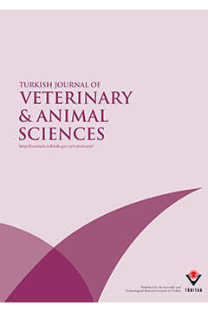Effect of breed on growth performance and carcass quality attributes of apparently healthy male weanling rabbits under a conventional housing system
Effect of breed on growth performance and carcass quality attributes of apparently healthy male weanling rabbits under a conventional housing system
___
- 1. Khan K, Khan S, Khan R, Sultan A et al. Growth performance and meat quality of rabbits under different feeding regimes. Tropical Animal and Health Production 2016; 48: 1661-1666.
- 2. OECD. Publishing and Food & Organization. OECDFAO agricultural outlook 2017-2026. Paris, France: OECD Publishing; 2017.
- 3. Makkar HP, Tran G, Heuzé V, Ankers P. State-of-the-art on use of insects as animal feed. Animal Feed Scienceand Technology 2014; 197: 1-33.
- 4. Saleh AA, Ebeid TA, Eid YZ. The effect of dietary linseed oil and organic selenium on growth performance and muscle fatty acids in growing rabbits. Pakistan Veterinary Journal 2013; 33: 450-454.
- 5. Belabbas R, De la Luz García M, Ainbaziz H, Benali N, Berbar A et al. Growth performances, carcass traits, meat quality, and blood metabolic parameters in rabbits of local Algerian population and synthetic line. Veterinary World 2019;12: 55- 62.
- 6. Njidda A, Isidahomen C. Hematological parameters and carcass characteristics of weanling rabbits fed sesame seed meal (Sesamum indicum) in a semi-arid region. Pakistan Veteriary Journal 2011; 31: 35-39.
- 7. Ali ME, Ahamad MNU, Hossain MM, Sultana S. Multiplex polymerase chain reaction-restriction fragment length polymorphism assay discriminates of rabbit, rat and squirrel meat in frankfurter products. Food Control 2018; 84: 148-158.
- 8. Petracci M, Soglia F, Leroy F. Rabbit meat in need of a hattrick: from tradition to innovation (and back). Meat Science 2018;146: 93-100.
- 9. Council N.R. Microlivestock: little-known small animals with a promising economic future. Washington, DC, USA: National Academies Press; 1991.
- 10. Khan K, Khan S, Khan N, Ahmad N. Production performance of indigenous rabbits under traditional and intensive production systems in Northern Pakistan. Journal of Animal and Plant Science 2017; 27: 75-81.
- 11. Khan S, Khan MH, Muhammad S, Kaleem K, Shah P et al. Phenotypic and morphometric characteristics of Angora rabbits in rabbit model farm Jabba Mansehra. Khyber Pakhtunkhwa-Pakistan 2017; 1: 68-71.
- 12. Khan K, Khan S, Khan NA, Naseer A. Effect of flaxseed supplementation of feed on growth, carcass yeld, meat and fatty acids profile of rabbit carcass. Pakistan Journalof Zoology 2018; 50: 2037-2043.
- 13. Hassan H, Elamin K, Yousif I, Musa A, Elkhairey M. Evaluation of body weight and some morphometric traits at various ages in local rabbits of Sudan. Journal of Animl Science Advances 2012; 2: 407-415.
- 14. Blasco A, Ouhayoun J. Harmonization of criteria and terminology in rabbit meat research. Revised proposal. World Rabbit Science 1993; 1: 3-10.
- 15. Paci G, Cecchi F, Preziuso G, Ciampolini R, D’Agata M. Carcass traits and meat quality of two different rabbit genotypes. Italian Journal of Animal Science 2012; 11: 249-252.
- 16. Papadomichelakis G, Zoidis E, Pappas A, Hadjigeorgiou I. Seasonal variations in the fatty acid composition of Greek wild rabbit meat. Meat Science 2017; 134: 158-162.
- 17. Yakubu A, Ayoade J. Application of principal component factor analysis in quantifying size and morphological indices of domestic rabbits. International Journal ofMorphology 2009; 27: 1013-1017.
- 18. Trocino A, Xiccato G, Queaque P, Sartori A. Effect of transport duration and sex on carcass and meat quality of growing rabbits. In: Proceedings of 2nd Rabbit Congress of the America; Cuba; 2002. pp. 232-235.
- 19. Dal Bosco A, Castellini C, Mugnai C. Rearing rabbits on a wire net floor or straw litter: behaviour, growth and meat qualitative traits. Livestock Production Science 2002; 75: 149-156.
- 20. Yalçın S, Onbaşılar E, Onbaşılar İ. Effect of sex on carcass and meat characteristics of New Zealand White rabbits aged 11 weeks. Asian-Australasian Journal of Animal Science 2006; 19: 1212-1216.
- 21. Yalçın S, Hacıoğlu E, Gürdoğan T, Oğuz N, Onbaşılar I. The usage of poplar sawdust in the rations of rabbit as a source of fiber. Tavukçuluk Araştırma Dergisi 2001; 3: 47-52.
- 22. Lang C, Hoy S. Investigations on the use of an elevated platform in group cages by growing rabbits. World Rabbit Science 2011; 19: 95-101.
- 23. Piles M, Blasco A, Pla M. The effect of selection for growth rate on carcass composition and meat characteristics of rabbits. Meat Science 2000; 54: 347-355.
- ISSN: 1300-0128
- Yayın Aralığı: 6
- Yayıncı: TÜBİTAK
Transcriptome sequencing analysis of ovarian granulosa cells in FecB hybrid ewe lamb
Cuiling WU, Chunxin WANG, Bo ZHA, Yunhui ZHAO, Zhuo ZHAO, Yuezhen TIAN, Kechuan TIAN, Mingxin ZHANG
Marwa H. HASSAN, Khaled M. ALI
Anatomical and histological studies on the eyes of brown bear (Ursus arctos horribilis)
Semine DALGA, Gülseren KIRBAŞ DOĞAN, Serap KORAL TAŞÇI, Serap İLHAN AKSU
Possible ensiling of pumpkin (Cucurbita pepo) residues
Mahmut KALİBER, Yusuf KONCA, Selma BÜYÜKKILIÇ BEYZİ, İsmail ÜLGER
Şükrü GÜRLER, Ünal YAVUZ, Esra KİRAZOĞLU
Sahar SULEMAN, Shahid Ali KHAN, Muhammad Haris AZIZ
Replacement of corn and soybean meal with corn gluten meal on rooster’s diet
Sérgio Leandro Costa de ÁVILA, Carolina Oreques de OLIVEIRA, Tiago Araújo RODRIGUES, Amauri Telles TAVARES, Sara Lorandi SOARES, Alexsander FERRAZ, Silvia Maria Lannes de Campos da COSTA, Denise Calisto BONGALHARDO, Marcos Antonio ANCIUTI, Mônica Corrêa LEDUR
